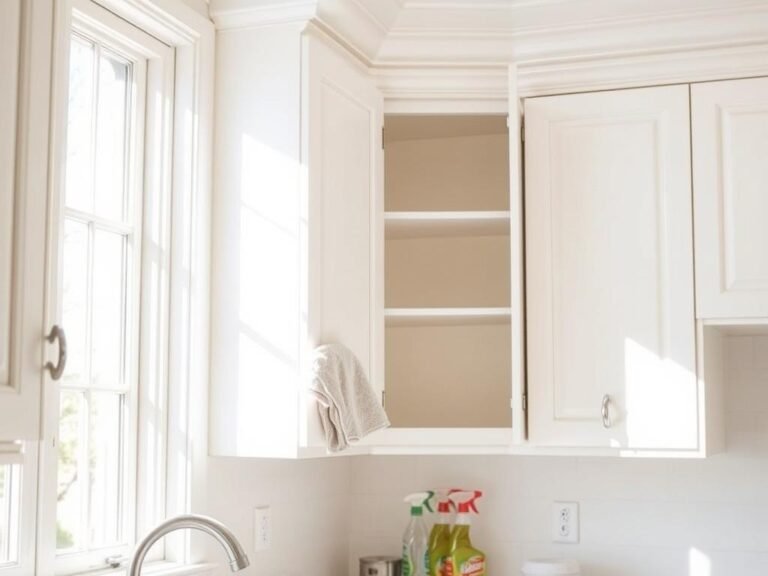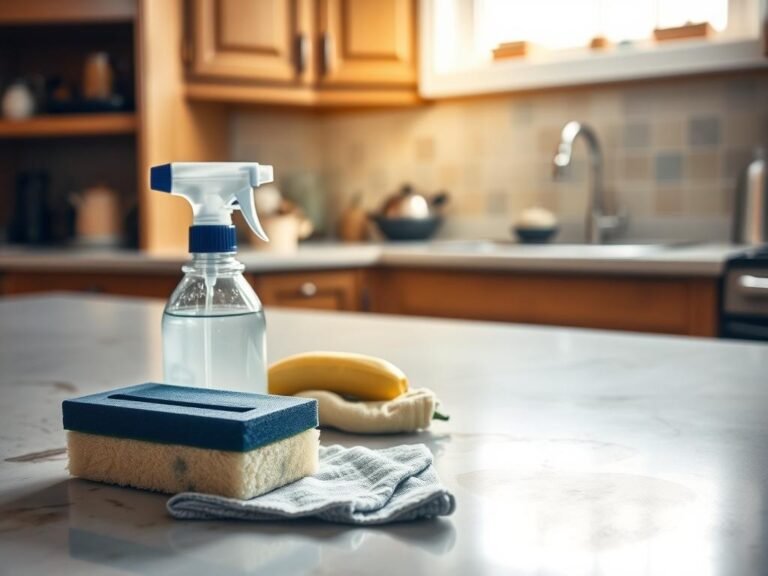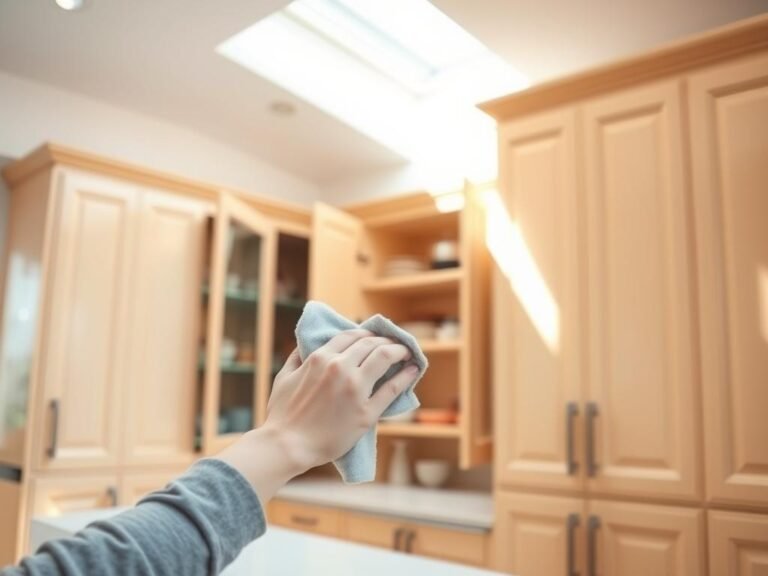Did you know that about 20% of mold cases in kitchens come from leaks under the sink1? Also, mold can make asthma worse in kids, showing how dangerous it is2. In this guide, I’ll share tips on how to get rid of mold in kitchen cabinets. You’ll learn about removing mold, cleaning cabinets, and more.
Mold can ruin your kitchen cabinets and is bad for your health. It can spread harmful spores to food and utensils2. We’ll cover the important steps to find, remove, and stop mold. This will help keep your kitchen clean and healthy.
Key Takeaways
- Leakage under the sink accounts for 20% of kitchen mold cases1.
- Regularly check your kitchen cabinets for mold, watching for color changes and bad smells2.
- Mold can make asthma in kids worse, so keeping your kitchen mold-free is key2.
- Keeping indoor humidity between 30-50% can stop mold from growing12.
- Using mold-resistant products can cut mold growth risk by up to 80%1.
Understanding the Causes of Mold in Kitchen Cabinets
Dealing with mold in kitchen cabinets can be tough. But knowing why it happens helps a lot.
Mold loves damp places with little air. That’s why kitchen cabinets are perfect for it3.
Common Moisture Sources
Moisture often comes from under the sink, near the dishwasher, and by exhaust vents. These spots get wet easily because they’re close to water3. Mold can grow fast here, turning a small spot into a big problem in just days4. To fix mold in kitchen cabinets, controlling moisture is key.
Impact of Ventilation
Good air flow is important to stop mold in kitchen cabinets. Without it, moisture gets stuck, helping mold grow3. Using range hoods or exhaust fans while cooking helps keep humidity down. This lowers the chance of mold4. The best way to remove mold is by making sure the kitchen has enough air.
Geographical Factors
Where you live also affects mold. Places with lots of humidity are more likely to have mold. This affects not just kitchen cabinets but the whole house5. Checking for leaks and moisture regularly helps a lot. Knowing your area’s humidity can help you fight mold better.
Health Risks Associated with Mold in Your Kitchen
Mold in the kitchen can be very harmful, mainly for people with health problems. It’s also bad for kids and the elderly. Mold spores grow fast in damp places and can cause breathing issues.
Respiratory Issues
Mold can cause many breathing problems. Kids are 30-50% more likely to get asthma from mold in their homes6. Most people can handle mold spores, but some get sick from them6.
The mold Aspergillus fumigatus can make asthma worse. It makes more mucus and can block airways6.
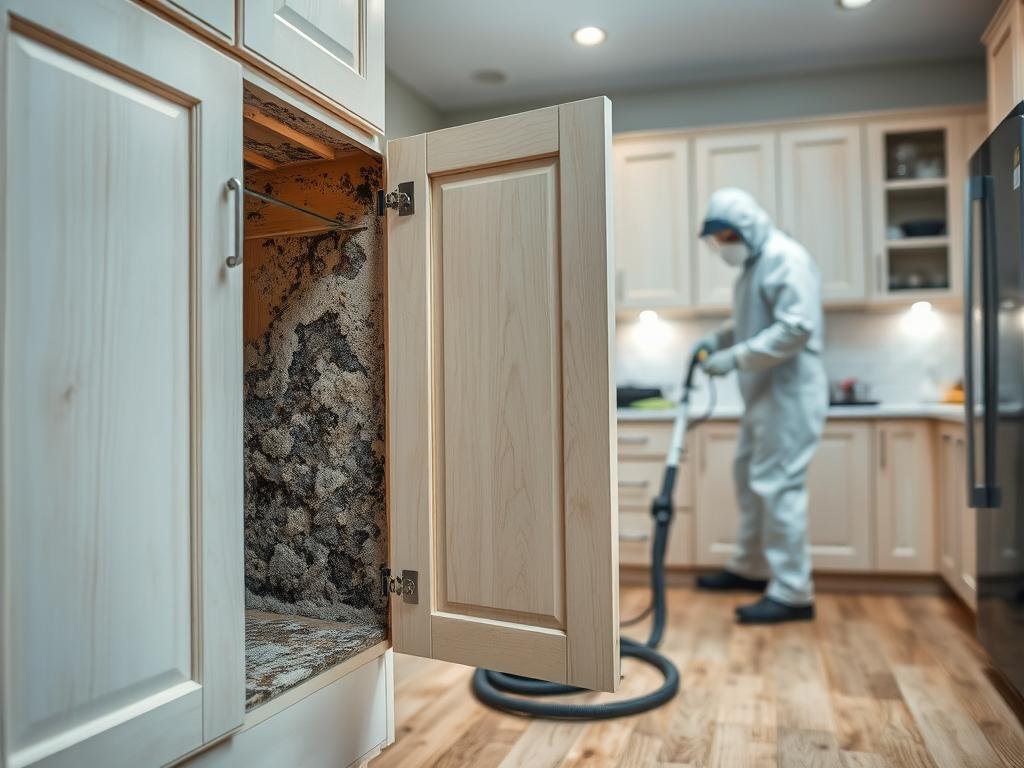
Allergic Reactions
Mold can also cause allergic reactions. Symptoms include stuffy nose, itchy eyes, and coughing7. About 10-20% of people get allergic reactions from mold, and it’s worse for those with asthma6.
Long-term Health Impacts
Long-term mold exposure can lead to serious health problems. People with lung issues are at higher risk of mold pneumonia6. Mold can also cause infections in those with weak immune systems8.
Exposure to a lot of mold can cause hypersensitivity pneumonitis. This is more common in work places than homes8.
It’s important to check your kitchen for mold often. Fix any moisture problems quickly to keep your home safe.
By taking care of mold in cabinets, you can keep your home healthy. Using good mold prevention in your kitchen helps everyone stay safe and healthy.
Identifying Mold in Kitchen Cabinets
Before you start cleaning mold from kitchen cabinets, you need to find it first. Knowing the signs of mold helps you see how big the problem is. Mold often comes from too much moisture, leaks, and bad air flow, which is common in places like South Florida910. These signs are key to a good cleaning guide.
Visual Indicators
Black, green, or white spots in your cabinets are clear signs of mold11. Black mold, or Stachybotrys chartarum, can look dark green to gray, not just black9. Checking often can stop big problems and is a key tip for removing mold from cabinets. Look for color changes around edges and inside drawers to check well.
Odor Signs
A musty smell means mold might be in your kitchen cabinets. If you smell something odd, check it out11. This smell comes from mold’s chemicals. A good cleaning guide says to watch for smells, which mean mold might be hiding.
Condensation and Moisture Buildup
Condensation on cabinets and around sinks can lead to mold10. Even small leaks can help mold grow, so fix plumbing fast9. Kitchens with high humidity, from cooking, are more likely to get mold910. Use a range hood or good air flow to help prevent this.
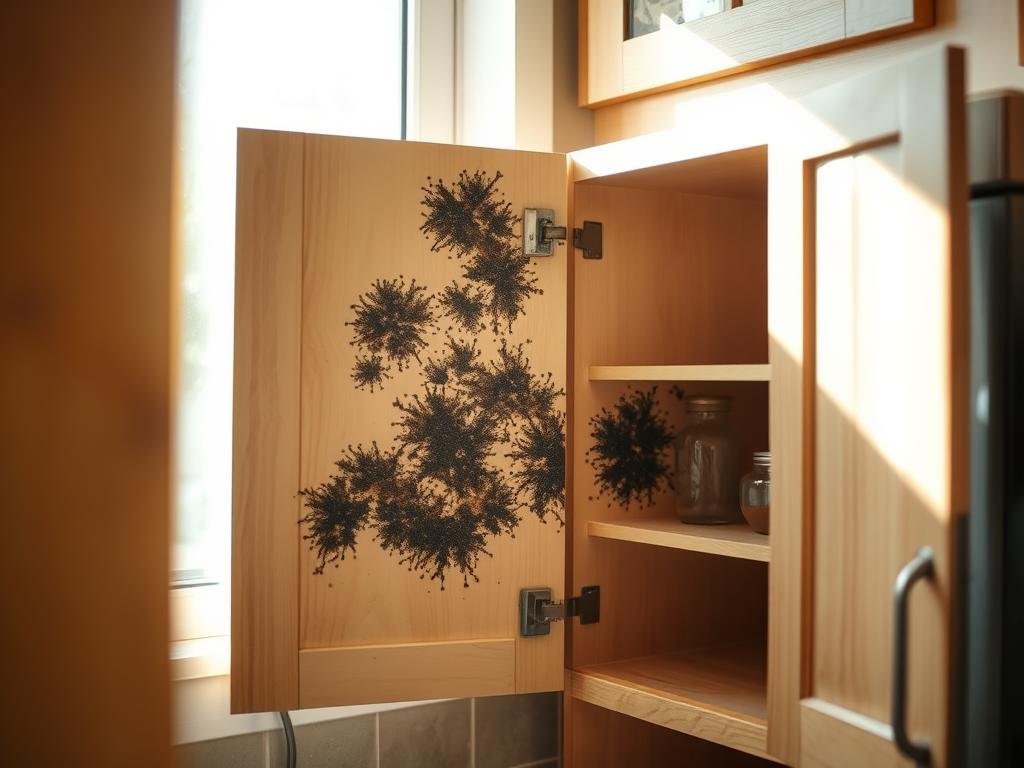
Preparation for Mold Removal
Before you start removing mold from kitchen cabinets, getting ready is key. This ensures safety and success. Follow these steps to boost your mold removal efforts.
Protective Gear
Keeping yourself safe from mold is very important. Wear respirators, gloves, and goggles. These can cut down mold spore exposure by up to 90%12. It’s essential, mainly when dealing with big mold problems in kitchen cabinets.

Ventilation Tips
Good ventilation is critical for removing mold from kitchen cabinets. Turn on exhaust fans to cut down airborne mold spores by about 60%. This lowers health risks and stops mold from spreading12. Also, use air scrubbers with HEPA filters to catch more mold spores and improve air quality13.
Gathering Cleaning Supplies
When getting ready to remove mold, choose safe and effective cleaning items. Opt for cleaners without ammonia, and natural options like vinegar or hydrogen peroxide. Knowing that chemical removers can work 90% of the time is important12. Having these supplies ready makes the process smoother and prepares you to fight mold well.
Also, having a moisture meter is helpful. It shows high mold risk at readings over 20%12. By following these steps, you’re laying a solid base for removing mold from your kitchen cabinets.
How to Remove Mold from Kitchen Cabinets
Removing mold from kitchen cabinets is key to a safe home. Cabinets can trap moisture, leading to mold. To remove mold, use both commercial and natural cleaners and follow a cleaning process.
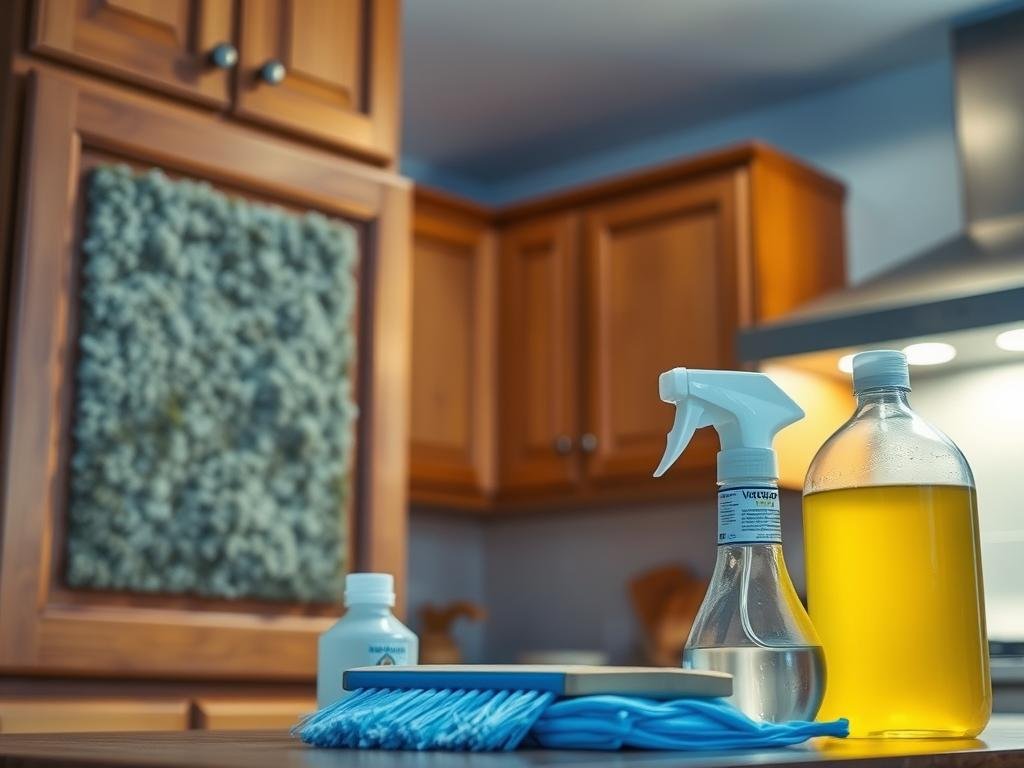
Using Commercial Cleaners
Commercial cleaners are very effective against mold. They have strong agents that kill mold spores. Always read the label to use them safely and effectively.
Natural Cleaning Solutions
Natural options like vinegar and baking soda work well. Vinegar kills mold with its acidity. Baking soda kills mold and absorbs moisture. Start with these before using bleach, as bleach can damage wood14.
Step-by-Step Cleaning Process
Follow a step-by-step process for mold removal:
- Start by preparing the area – Open windows and run fans for ventilation. Remove items and scrub the moldy spots with a brush.
- Apply your chosen cleaner – Use a lot of your chosen cleaner on the moldy spots.
- Scrub thoroughly – Scrub the mold well, focusing on corners. Use commercial cleaners for their mold-killing power15.
- Rinse the area – Rinse with clean water to remove the cleaner and mold.
- Dry completely – Dry the cabinets well to stop mold from coming back. Use a dry cloth and leave doors open until dry14.
- Dispose of contaminated materials – Throw away any items that touched the mold to avoid spreading it.
This detailed method helps remove mold from cabinets and keeps them mold-free. Regular checks and care are needed to keep your cabinets clean.
Mold Prevention Strategies for Kitchen Cabinets
Keeping kitchen cabinets mold-free is key to a healthy kitchen. Good ventilation, managing humidity, and regular cleaning are important steps. These actions help keep your kitchen in top shape.
Improving Ventilation
Good air flow is vital to stop mold in kitchen cabinets. Cooking creates steam that can cause mold if not aired out16. Using exhaust fans and keeping vents clear helps reduce moisture and mold risk.
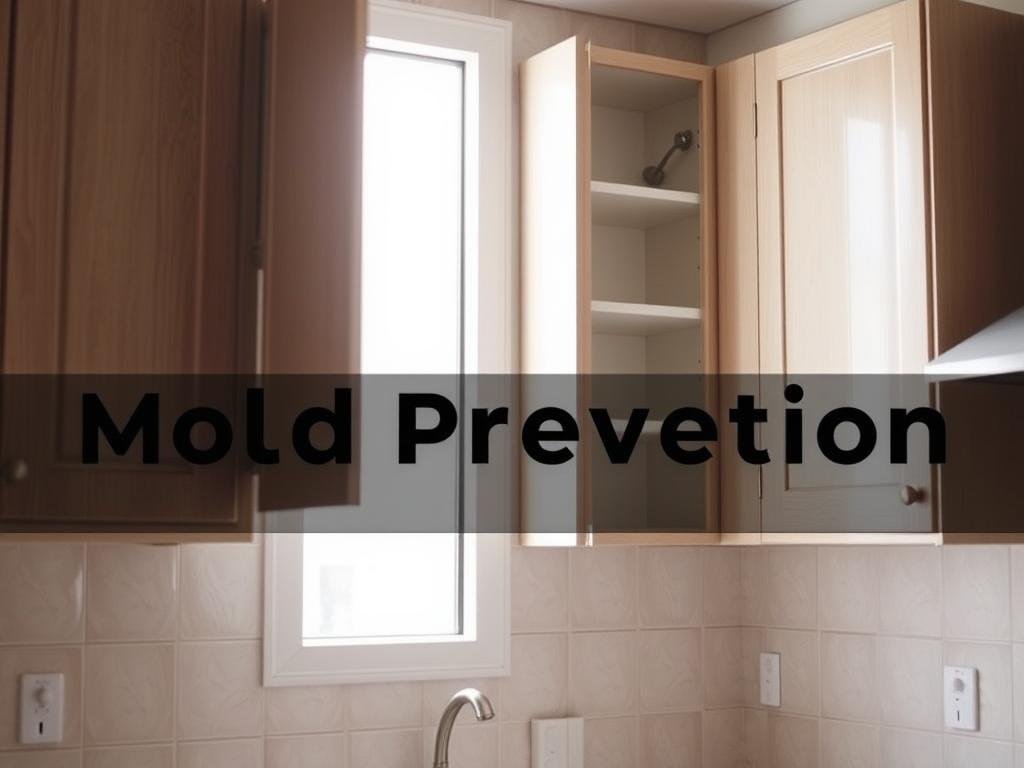
Managing Humidity Levels
Keeping the right humidity in your kitchen is also important. A hygrometer helps keep humidity between 35-50% to stop mold17. In humid areas, using dehumidifiers and air conditioners helps control humidity levels.
Regular Maintenance and Cleaning
Regular checks and cleanings are key to keeping cabinets mold-free. Look for mold signs like discoloration and musty smells16. Clean spills and moisture right away to stop mold16. Regular cleaning and checking for leaks can stop mold spores and their food sources.
Signs You Need Professional Mold Remediation
Knowing when to call for professional mold help is key to avoiding health issues and costly repairs. Mold can hide in places like ventilation systems, making it hard to find without an expert18. Look out for visible stains on walls or ceilings and musty smells. These signs often mean you need a pro’s help18.
Big mold problems, like those from water damage, need a pro to fix18. Mold loves humid places, like Florida, which raises the risk of getting sick from it19. Because mold can hide in walls and ducts, you really need a pro to find and get rid of it19.
Experts use special tools to find and remove mold safely18. If you have allergies or breathing issues, watch out for mold signs. About 10% of people are more at risk20. Also, homes with bad air flow or too much moisture, like bathrooms without fans, are more likely to get mold19.
A good guide for cleaning mold from cabinets says to call a pro if you see wood warping, paint cracking, or other signs of moisture20. Getting a pro to fix the mold also helps fix the underlying problems. This stops mold from coming back19.
In short, getting help from mold experts is a must when mold spreads a lot or keeps coming back. They not only get rid of the mold but also help keep your home safe and mold-free.
Effectiveness of DIY Mold Removal
Trying to remove mold yourself can work for small problems. But, it’s important to know the good and bad sides of doing it yourself.
Pros and Cons
One big plus of DIY mold removal is saving money. Using things like white vinegar can kill mold, viruses, and bacteria21. Tea tree oil also stops mold from coming back21.
But, DIY might not be enough for big mold problems. It’s not good for mold in HVAC systems or toxic molds like black mold22. Touching mold can also be risky, as spores can spread in the air23.
When DIY Is Sufficient
DIY works well for small mold spots, less than 10 square feet. The EPA says this is okay22. White vinegar and hydrogen peroxide can get rid of mold in cabinets better than bleach22.
Cleaning damp areas with natural products helps keep mold away. This keeps your kitchen cabinets mold-free21.
When to Seek Professional Help
If DIY doesn’t work or if mold grows a lot, get a pro. Experts are needed for mold over 10 square feet22. If mold is near HVAC systems or looks dangerous, like black mold, call a pro22.
Getting a professional ensures mold is fully removed. This greatly lowers the risk of exposure.
Best Cleaning Solutions for Kitchen Cabinet Mold
To remove mold from cabinets, you might need both commercial and homemade solutions. The right choice depends on how bad the mold is, what materials you have, and your health.
High-Efficiency Products
Commercial mold cleaners are great for tough mold. They can cut mold growth in half24. Air scrubbers with HEPA filters also help, removing almost all mold spores24. It usually takes 1 to 3 hours to clean kitchen cabinets, based on how bad the mold is24.
Homemade Remedies
For mild mold, homemade solutions work well. A mix of white vinegar and water is a good choice. Apply it to the mold and let it sit for 10 to 15 minutes25. Baking soda paste is another option, helping prevent mold later25.
Keeping your home’s humidity between 30-50% also stops mold24. Check your home for mold every 3-6 months, more often in damp areas24.
Maintaining a Mold-Free Kitchen Beyond Cabinets
Keeping your kitchen mold-free is key to better health and cleanliness. You need to watch under the sink, walls, floors, and appliances closely. Regular checks and cleanings help keep these spots free from mold.
Dealing with Mold Under the Sink
Mold can grow on food scraps if water stays for over 24 hours26. Clean the sink every day and avoid water sitting to stop mold. White vinegar in dish soap fights bacteria and molds well26.
Fix leaks fast to stop mold growth27. The kitchen sink is a common mold spot. So, it’s important to keep it dry and clean.
Mold on Kitchen Walls and Floors
Removing mold from walls and floors is vital for a clean kitchen. Mold can spread fast on damp surfaces in 24 to 48 hours27. Use mold-resistant paint on walls to stop mold, which is good for moist kitchens26.
Clean floors often to stop mold growth. Use a hygrometer to check humidity and prevent mold28. Keep the kitchen dry and well-ventilated to avoid mold from too much moisture.
Keeping Appliances Mold-Free
Keeping appliances clean is important to stop mold. Fridges, microwaves, and dishwashers can get moldy from food and moisture28. Clean these often and change kitchen sponges weekly to stop mold buildup28.
Good ventilation with exhaust fans helps lower humidity and stops mold in appliances27. Throw away leftover food quickly to avoid mold.
By focusing on these areas, you can keep your kitchen mold-free. Regular cleaning, good air flow, and fixing moisture problems are the main steps.
Conclusion
Mold loves damp and humid places, like kitchens. To stop mold, check for moisture often and clean it up fast. The CDC says every mold problem is serious, even if it’s not toxic.
People with asthma or allergies should be careful around mold. Mold can hurt wood over time. So, use mold-resistant stuff and keep humidity between 30% and 50%29.
Good tips for stopping mold in kitchens include good air flow and fixing leaks right away. Mold grows on spills and leaks, making big problems30. Natural cleaners like vinegar and citric acid work well against mold31.
For big mold problems, get help from mold experts, says the EPA29. Use mold-resistant insulation and good air flow to stop mold31. Follow these steps to keep your kitchen mold-free and safe.


